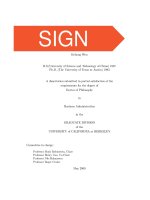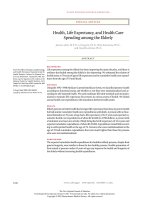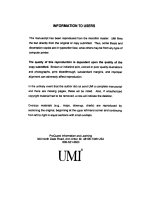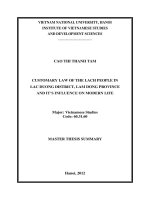Essays on forecasting life expectancy and fiscal sustainability 1
Bạn đang xem bản rút gọn của tài liệu. Xem và tải ngay bản đầy đủ của tài liệu tại đây (101.78 KB, 12 trang )
ESSAYS ON FORECASTING LIFE EXPECTANCY
AND FISCAL SUSTAINABILITY
TAN SIOK HONG
(BACHELOR OF ARTS, NUS;
BACHELOR OF SOCIAL SCIENCES (HONS.), NUS;
MASTERS OF SOCIAL SCIENCES (APPLIED
ECONOMICS), NUS)
A THESIS SUBMITTED
FOR THE DEGREE OF DOCTOR OF PHILOSOPHY
DEPARTMENT OF ECONOMICS
NATIONAL UNIVERSITY OF SINGAPORE
2011
ii
ACKNOWLEDGEMENTS
I would first like to express my deepest gratitude to my supervisor,
Associate Professor Chia Ngee Choon, for her willingness to supervise me, her
unlimited patience, motivation and constant encouragement. This thesis would not
be possible without her valuable guidance, generous suggestions and support.
I am equally grateful to my co-supervisor, Associate Professor Tsui Ka
Cheng, Albert. I have benefited greatly from his constructive ideas and generous
coaching, especially the technical aspects of my research. His interest in research
work and encouragement has kept me interested and motivated throughout.
I would also like to extend appreciation to other Faculty staff who have
previously taught and helped me, not forgetting the staff of the Economics
Department and my friends in NUS for their support and advice.
Last but not the least, I am greatly indebted to my family and loved ones.
This had been a long journey and I am very fortunate to receive their constant
encouragement and support while I pursue my dream.
iii
TABLE OF CONTENTS
Acknowledgements
ii
Table of Contents
iii
Overview
v
List of Tables
viii
List of Figures
x
Essay 1: Forecasting Life Expectancy
1
1.1. Introduction
1
1.2. Literature Review
4
1.3. Empirical Model
9
1.4. Data and Estimation Results of LC-GARCH Models
16
1.5. Multivariate Conditional Volatility Models
30
1.6. Lee-Carter Model with Time-Varying Correlations
41
1.7. Estimation Results of LC-VC-GARCH Model
43
1.8. Forecast Comparisons
54
1.9. Concluding Remarks
62
References
65
Appendix 1A
75
Essay 2: Forecasting Real GDP Growth Rates Using Mortality Index
79
2.1. Introduction
79
iv
2.2. Literature Review
85
2.3. Data and Variables
91
2.4. VC-MGARCH Model
102
2.5. Estimation Results
106
2.6. Discussion
113
2.7. EGARCH-in-Mean Forecasting Model
118
2.8. Concluding Remarks
127
References
128
Essay 3: Fiscal Impacts of Population Ageing in Singapore
139
3.1. Introduction
139
3.2. Literature Review
143
3.3. Lee & Edwards (2001) Model
150
3.4. Population Ageing and Budgetary System in Singapore
156
3.5. Age Specific Benefit and Taxes
170
3.6. Projecting Demographic Changes in Singapore
186
3.7. Projected Fiscal Pressures for Singapore
200
3.8. Discussion
220
3.9. Concluding Remarks
226
References
229
Appendix 3A
236
Appendix 3B
237
Appendix 3C
238
v
OVERVIEW
This thesis covers three broad objectives. Firstly, we extend an existing
popular mortality model to improve forecasts of mortality and life expectancy
rates. Secondly, we use the improved demographic projections as inputs and show
that it is capable of enhancing the performance of term spread in generating
forecasts of GDP growth rates. Lastly, as mortality changes directly affect fiscal
sustainability, we use the improved demographic projections to examine the fiscal
impacts of population ageing in Singapore.
The first essay is focused on improving forecasts of life expectancy rates.
The Lee-Carter (LC) model is a popular model but being a simple model, it
assumes homoskedasticity. We believe that there is scope to value-add to the
existing literature by relaxing this assumption. Essay one first extends the classical
LC model with GARCH-type structures to allow for volatility clustering in its
time-varying component. This allows us to model the presence of conditional
volatility in mortality rates. Next, the model is further extended with time-varying
multivariate GARCH models to account for, not just conditional volatility, but also
the presence of conditional correlations between the male and female mortality
series. The idea is that male and female populations within each country are
exposed to the same underlying demographic history, medical and other conditions,
resulting in a certain degree of correlations between their mortality data series. In
essay one, we show that modeling both the presence of conditional volatility and
correlations offer the greatest improvements to forecasts of life expectancy at birth
and at retirement age.
vi
In the second essay, we are interested to examine if including the use of
demographic projections can enhance the usefulness of the term spread in
forecasting GDP growth rates. Term spread has been commonly used to forecast
real GDP growth rates but evidences of its forecasting ability have been mixed
across countries and overtime. There are also signs that its forecasting ability has
declined over the years. In essay two, we seek to examine both the relevance of
term spread as well as the contributions of mortality indexes in forecasting real
GDP growth rates. We first use multivariate GARCH models to investigate the
evidence of conditional correlations between real GDP growth rates, term spreads
and mortality indexes, which has not been attempted in the literature. Next, we
show that including the use of conditional volatility of male mortality indexes,
together with term spreads, helps to improve forecasts of real GDP growth rates.
This finding supports that the improved demographic forecasts in essay one using
LC method extended with multivariate GARCH model has important and useful
implications towards macroeconomic forecasting.
In the last essay, we are primarily interested in the study of the fiscal
impacts of population ageing in Singapore. Demographic changes produce direct
and significant effects on fiscal sustainability and with a rapidly ageing population
in Singapore, the demographic shift caused by a shrinking working age group and
smaller income tax base is expected to impose increasingly important fiscal
implications. In order to derive an accurate assessment of future fiscal burdens
brought about by demographic pressures, it is important to have accurate
projections of future population changes. Using the methodology of stochastic
vii
demographic projections obtained from the LC method extended with time-varying
multivariate GARCH model in essay one, we first project how the population
ageing problem is expected to worsen in Singapore and how it will impact the
government fiscal position over the next twenty years. The baseline results show
that the fiscal support ratio for Singapore will fall and the cost of providing existing
benefit policies will inevitably increase as population ages. In addition to the case
of pure demographic effects, we also included several calibration analysis to
account for an increase in immigration figures, an extension of retirement age, an
increase in female labor force participation rates, and an increase in labor force
productivity rates. The calibration results supports that the rate of decline in the
fiscal support ratio under the baseline scenario will be moderated with higher
immigrant inflow, extended retirement age, larger female labor force and higher
labor force participation rates.
viii
LIST OF TABLES
Essay 1: Forecasting Life Expectancy
1.1
Descriptive Statistics and Unit Root Tests for Time-Varying Mortality Index
1.2
Descriptive Statistics & Unit Root Tests for Time-Varying Mortality Index after
First Differencing
1.3
Estimated Parameters of LC-Univariate GARCH Model
1.4
Estimated Parameters of LC-EGARCH Model
1.5
Estimated Parameters for LC-CCC-GARCH Model
1.6
Estimated Parameters for LC-VC-GARCH Model
1.7
Forecast Error Comparison: Life expectancy at Age 0
1.8
Forecast Error Comparison: Life expectancy at Age 65
1.9
Actual & Forecasted e
0
under LC-VC-GARCH, LC-GARCH & LC- Random
Walk with Drift Models
1.10
Actual & Forecasted e
65
under LC-VC-GARCH, LC-GARCH & LC-Random
Walk with Drift Models
Essay 2: Forecasting Real GDP Growth Rates Using Mortality Index
2.1
Variables and Period of Data Used
2.2
Descriptive Statistics
2.3
Pearson Product-Moment Correlations by Country
2.4
Estimation Results for VC-MGARCH Model
2.5
Model I: Parameter Estimates and Diagnostic Tests
ix
2.6
Model II: Parameter Estimates & Diagnostic Tests
2.7
Forecast Results of Annual Real GDP Growth Rates
2.8
Forecast Error Measurements
Essay 3: Fiscal Impacts of Population Ageing in Singapore
3.1
Share of Singapore Residents, Non-Residents and Average Growth Rates
3.2
Age Composition for Total Population, 1980 & 2009
3.3
Number of Working-Age Population to Sustain Each Elderly, 1980-2008
3.4
FY2008 Revised Operating & Development Expenditure
3.5
Categorization of Benefits (Age-Specific, Public & Social Goods and Services)
3.6
FY2008 Revised Revenue Receipts
3.7
Parameter Estimates for LC-VC-GARCH Models
3.8
Summary of Fiscal Support Ratios for Baseline Case
3.9
Average Benefits Received in FY08 – Females
3.10
Average Benefits Received in FY08 – Males
3.11
Average Taxes Paid in FY08 – Females
3.12
Average Taxes Paid in FY08 – Males
x
LIST OF FIGURES
Essay 1: Forecasting Life Expectancy
1.1
Plots of Time-Varying Mortality Index
1.2
Plots of Time-Varying Mortality Index After First Differencing
1.3
Plots of Conditional Volatility Under LC-Univariate GARCH Models
1.4
Plots of Conditional Volatility Under LC-VC-GARCH Models
1.5
Plots of Time-Varying Correlations
1.6
Actual and Forecast Values for Life Expectancy at Birth
1.7
Actual and Forecast Values for Life Expectancy at Age 65
Essay 2: Forecasting Real GDP Growth Rates Using Mortality Index
2.1
Annual Real GDP Growth Rates
2.2
Annual Term Spreads & Recessions
2.3
Annual Mortality Indexes for Males and Females
2.4
Time Paths of Conditional Correlations
2.5
Conditional Volatility with Recession Periods
Essay 3: Fiscal Impacts of Population Ageing in Singapore
3.1
Population Ageing Caused by Lower Fertility Rates - Lower Benefits &
Lower Taxes
3.2
Population Ageing Caused by Lower Fertility Rates - Lower Benefits & Higher
Taxes
xi
3.3
Time-Line of Demographic Changes
3.4
Age Pyramid for Singapore, Males and Females
3.5
Total Fertility Rates, 1960-2008
3.6
Crude Death Rates, 1960-2008
3.7
Age-Specific Death Rates, 1997 & 2008
3.8
Life Expectancies at Birth and Age 65
3.9
Young, Old and Total Dependency Ratios
3.10
Operating Revenue, Expenditure Outlay and Budget Position, 1999-2008
3.11
Budget Surpluses/Deficits, 1996-2008
3.12
Expected Growth in Elderly Healthcare Consumption
3.13
Average Benefit by Age in FY2008 - Females
3.14
Average Benefit by Age in FY2008 - Males
3.15
Average Tax Payments by Age in FY2008 - Females
3.16
Average Tax Payments by Age in FY2008 - Males
3.17
Plots of Conditional Volatility Under LC-VC-GARCH Models
3.18
Plot of Time-Varying Correlations between Male & Female Population Series
3.19
Age Pyramid, Actual 2009 & Projected 2029
3.20
Old Age Support Ratio, Actual 2009 & Projected 2029
3.21
Projected Female Population Structure, 2009-2029
3.22
Projected Male Population Structure, 2009-2029
3.23
Projected Changes in Female Dependency Ratios, 2009-2029
3.24
Projected Changes in Male Dependency Ratios, 2009-2029
3.25
Projected Changes in Total Dependency Ratios, 2009-2029
xii
3.26
Projected Government Revenue and Expenditure, 2010-2029
3.27
Projected Budget Surplus/Deficit, 2010-2029
3.28
Projected Fiscal Support Ratio, 2010-2029
3.29
Required Change in b(t) for Budget Balance
3.30
Required Change in d(t) for Budget Balance
3.31
Projected Dependency Ratios with 5% Yearly Increase in Immigrants
3.32
Projected Budget Surplus/Deficit with 5% Yearly Increase in Immigrants
3.33
Projected Fiscal Support Ratios with 5% Yearly Increase in Immigrants
3.34
Projected Fiscal Support Ratios with 10% Yearly Increase in Immigrants
3.35
Projected Dependency Ratios with Retirement Age Raised to 70
3.36
Projected Budget Surplus/Deficit with Retirement Age Raised to 70
3.37
Projected Fiscal Support Ratio with Retirement Age Raised to 70
3.38
Projected Budget Surplus/Deficit with 1% Yearly Increase in FLFPR
3.39
Projected Fiscal Support Ratio with 1% Yearly Increase in FLFPR
3.40
Projected Budget Surplus/Deficit with Yearly Reductions in Labor Productivity
3.41
Projected Fiscal Support Ratios with Yearly Reductions in Labor Productivity
3.42
Projected Budget Surplus/Deficit with Yearly Increase in Labor Productivity
3.43
Projected Fiscal Support Ratio with Yearly Increase in Labor Productivity
3.44
FY2008 Budget Distribution









